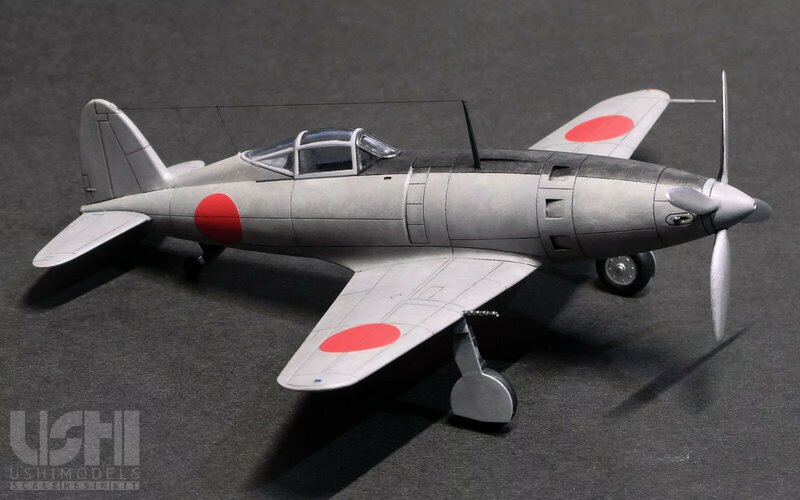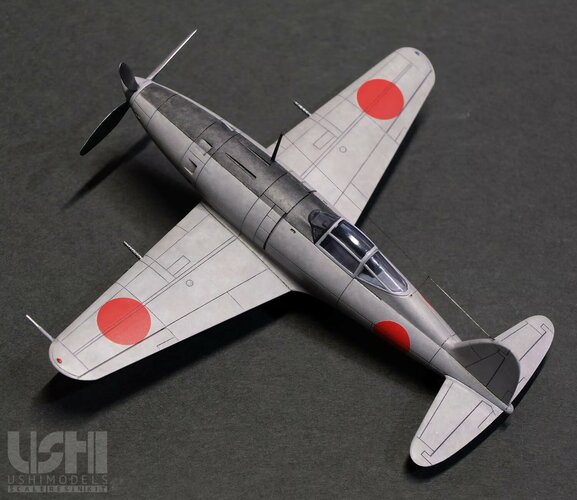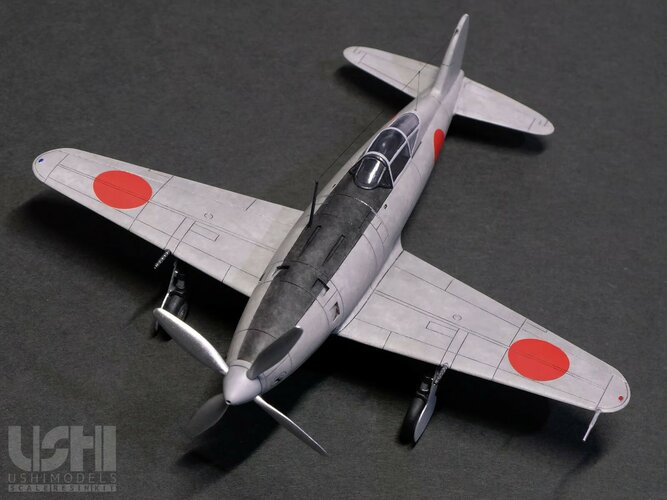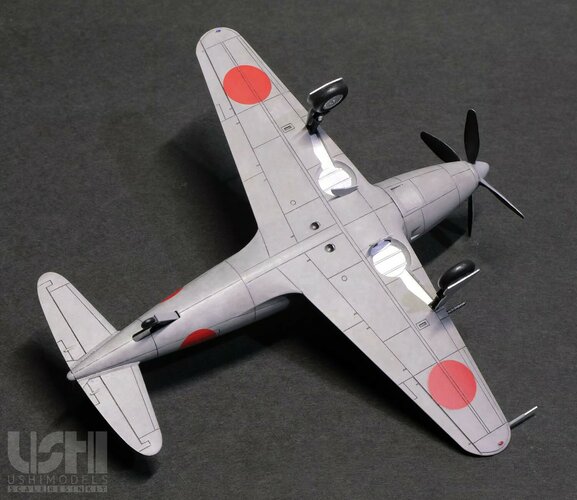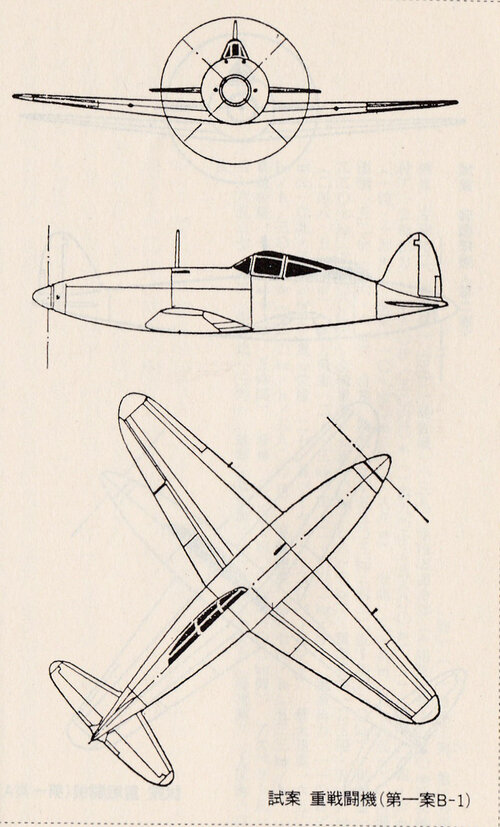From "Axis suicide squads"
Aircraft manufacturers competed for the few in-line available engines in 1939. With the potentially deteriorating situation that a long war could create, some aerodynamic essays were performed to reduce the radial engines drag in Germany, Belgium and the USA. The Renard R-37 was introduced to the public in July 1939 as an emergency solution, in face of the prospect that France and the United Kingdom might cancel the exports of the Hispano-Suiza and Merlin in-line engines. The R-37 was propelled by a large Gnome-Rhône engine of 1,100 hp with a large propeller spinner which completely covered the engine front air intake.
In Germany, the Focke Wulf Company had the same problem after realising that the whole production of Daimler Benz in-line engines had been assigned to Messerschmitt. The design team of Kurt Tank was impelled to use the BMW radial engine for the new Fw 190 fighter, a prototype of which flew in June 1939 with an extremely aerodynamic cowling and a large ducted spinner to reduce drag.
In USA the NACA published a report at the beginning of 1939 about the methods to improve the volume of cooling air flowing over radial engines. In February 1939, Seversky performed the first flight tests with the NX2597 AP-4 ‘Lancer’ prototype, equipped with ducted and non-ducted large propeller spinners. In March, the Curtiss Company decided to experiment with the new technology transforming the P-36A s/n 38-004 into the XP-42 prototype by adding a large propeller spinner and extension shaft with air intake under the engine.
In May, the Japanese flight tested the third prototype of the Kawasaki Ki-45 with a spinner that was almost identical to that of the Fw 190 V1. The NX21755 c/n 142 Vultee 48 fighter flew for the first time in September with an equipment similar to that of the Curtiss XP-42.
By mid 1939 the Northrop Company tested the A-17A s/n 36-184 bomber with ducted and non-ducted large propeller spinners and several nose and side mounted blowers configurations. In United Kingdom, the Hawker Company performed several late experiments by the beginning of 1945, modifying the Tempest Mk.V NV768 with several types of ducted spinners.
As a result of all this research, however, there was not any significant aerodynamic achievement. The R-37 was captured by the Germans before starting its flight tests and the Fw 190 V1, the Curtiss XP-42, the Vultee 48, the Kawasaki Ki.45-03 and the Seversky ‘Lancer’ all encountered insurmountable cooling problems and had to be refitted with conventional cowlings. The A-17 A was turned back to its original configuration and back to operations.
When the team of Jiro Horikoshi started the design of the Raiden, by the end of 1939, the result of previously described experiments that were understandably kept secret was unknown at Mitsubishi. It was also ignored that the XP-42 extension shaft had suffered serious problems of vibrations. At this time the main worry of the IJN was the possibility that the North American B-17 that was able to fly at 11,000 m would be operational. Every naval fighter of the 30s was designed to protect the fleet against low altitude attacks by torpedoes and dive bombers, but a four engine heavy bomber could attack the Japanese naval bases from a high altitude without any opposition. The whole Zero manufacturing programme might be modified or even cancelled if the B-17 was mass produced and operated from the air bases of Philippines and Central China.
And so, the IJN published a specification for the design of a fighter able to intercept a B-17 flying at a speed of 600 km/h and an altitude of 6,000 m with a climbing time of 5 minutes. However, when the enemy bombers first appeared over Tokyo they were of the B-29 type, flying at a speed of 575 km/h and an altitude of 7,600 m with an absolute ceiling of 9,700 m. They were so large, heavy and powerful that the turbulence they created in the air could produce a total loss of control to the small Ki.44 fighters of the IJA that tried to intercept them. The key was in the superchargers of their huge engines. Their manufacturing techniques were considered top secret up to an extent that not even the Australian of British Allies had access to them.
Japan lacked the experience or the technology to duplicate the samples obtained from the airplanes that were shot down and their attempts with the Ki.100 and the J2M4 did not achieve practical results. It was also impossible for the IJN to have access to the German Daimler Benz in-line engines, given their rivalry with IJA that have acquired the manufacturing licence of the DB 601A for the Ki.60 fighter. Like the Italians, they could only pursue the aerodynamic solution.
The Raiden was designed with a fuse shaped fuselage with a propeller extended shaft like that in the XP-42 to permit a finely tapered cowling, a narrow annular air intake like that in the Renard R-37 and the engine-driven fan like that in the Focke Wulf Fw 190 V1. The cockpit was extremely shallow with curved windscreen and the wings were shorter than those used by the Zero with laminar flow aerofoil section.
The selected radial engine was the most powerful available with water-methanol injection system. The armament was the same than that of the Zero, two Type 97 machine guns of 7.7 mm and two Type 99 cannons of 20 mm. Real combat experience showed that all this was wrong; pilots complained of lack of visibility and the curved windscreen cockpit was replaced by a flat panel windscreen to avoid optical distortion. The extended shaft caused serious problems of vibrations and, as a consequence, the engine attachment points and the cowling fasteners had to be reinforced, the number of fan blades reduced and the propeller replaced by a more rigid one with a hydraulically controlled system.
Aircraft manufacturers competed for the few in-line available engines in 1939. With the potentially deteriorating situation that a long war could create, some aerodynamic essays were performed to reduce the radial engines drag in Germany, Belgium and the USA. The Renard R-37 was introduced to the public in July 1939 as an emergency solution, in face of the prospect that France and the United Kingdom might cancel the exports of the Hispano-Suiza and Merlin in-line engines. The R-37 was propelled by a large Gnome-Rhône engine of 1,100 hp with a large propeller spinner which completely covered the engine front air intake.
In Germany, the Focke Wulf Company had the same problem after realising that the whole production of Daimler Benz in-line engines had been assigned to Messerschmitt. The design team of Kurt Tank was impelled to use the BMW radial engine for the new Fw 190 fighter, a prototype of which flew in June 1939 with an extremely aerodynamic cowling and a large ducted spinner to reduce drag.
In USA the NACA published a report at the beginning of 1939 about the methods to improve the volume of cooling air flowing over radial engines. In February 1939, Seversky performed the first flight tests with the NX2597 AP-4 ‘Lancer’ prototype, equipped with ducted and non-ducted large propeller spinners. In March, the Curtiss Company decided to experiment with the new technology transforming the P-36A s/n 38-004 into the XP-42 prototype by adding a large propeller spinner and extension shaft with air intake under the engine.
In May, the Japanese flight tested the third prototype of the Kawasaki Ki-45 with a spinner that was almost identical to that of the Fw 190 V1. The NX21755 c/n 142 Vultee 48 fighter flew for the first time in September with an equipment similar to that of the Curtiss XP-42.
By mid 1939 the Northrop Company tested the A-17A s/n 36-184 bomber with ducted and non-ducted large propeller spinners and several nose and side mounted blowers configurations. In United Kingdom, the Hawker Company performed several late experiments by the beginning of 1945, modifying the Tempest Mk.V NV768 with several types of ducted spinners.
As a result of all this research, however, there was not any significant aerodynamic achievement. The R-37 was captured by the Germans before starting its flight tests and the Fw 190 V1, the Curtiss XP-42, the Vultee 48, the Kawasaki Ki.45-03 and the Seversky ‘Lancer’ all encountered insurmountable cooling problems and had to be refitted with conventional cowlings. The A-17 A was turned back to its original configuration and back to operations.
When the team of Jiro Horikoshi started the design of the Raiden, by the end of 1939, the result of previously described experiments that were understandably kept secret was unknown at Mitsubishi. It was also ignored that the XP-42 extension shaft had suffered serious problems of vibrations. At this time the main worry of the IJN was the possibility that the North American B-17 that was able to fly at 11,000 m would be operational. Every naval fighter of the 30s was designed to protect the fleet against low altitude attacks by torpedoes and dive bombers, but a four engine heavy bomber could attack the Japanese naval bases from a high altitude without any opposition. The whole Zero manufacturing programme might be modified or even cancelled if the B-17 was mass produced and operated from the air bases of Philippines and Central China.
And so, the IJN published a specification for the design of a fighter able to intercept a B-17 flying at a speed of 600 km/h and an altitude of 6,000 m with a climbing time of 5 minutes. However, when the enemy bombers first appeared over Tokyo they were of the B-29 type, flying at a speed of 575 km/h and an altitude of 7,600 m with an absolute ceiling of 9,700 m. They were so large, heavy and powerful that the turbulence they created in the air could produce a total loss of control to the small Ki.44 fighters of the IJA that tried to intercept them. The key was in the superchargers of their huge engines. Their manufacturing techniques were considered top secret up to an extent that not even the Australian of British Allies had access to them.
Japan lacked the experience or the technology to duplicate the samples obtained from the airplanes that were shot down and their attempts with the Ki.100 and the J2M4 did not achieve practical results. It was also impossible for the IJN to have access to the German Daimler Benz in-line engines, given their rivalry with IJA that have acquired the manufacturing licence of the DB 601A for the Ki.60 fighter. Like the Italians, they could only pursue the aerodynamic solution.
The Raiden was designed with a fuse shaped fuselage with a propeller extended shaft like that in the XP-42 to permit a finely tapered cowling, a narrow annular air intake like that in the Renard R-37 and the engine-driven fan like that in the Focke Wulf Fw 190 V1. The cockpit was extremely shallow with curved windscreen and the wings were shorter than those used by the Zero with laminar flow aerofoil section.
The selected radial engine was the most powerful available with water-methanol injection system. The armament was the same than that of the Zero, two Type 97 machine guns of 7.7 mm and two Type 99 cannons of 20 mm. Real combat experience showed that all this was wrong; pilots complained of lack of visibility and the curved windscreen cockpit was replaced by a flat panel windscreen to avoid optical distortion. The extended shaft caused serious problems of vibrations and, as a consequence, the engine attachment points and the cowling fasteners had to be reinforced, the number of fan blades reduced and the propeller replaced by a more rigid one with a hydraulically controlled system.

